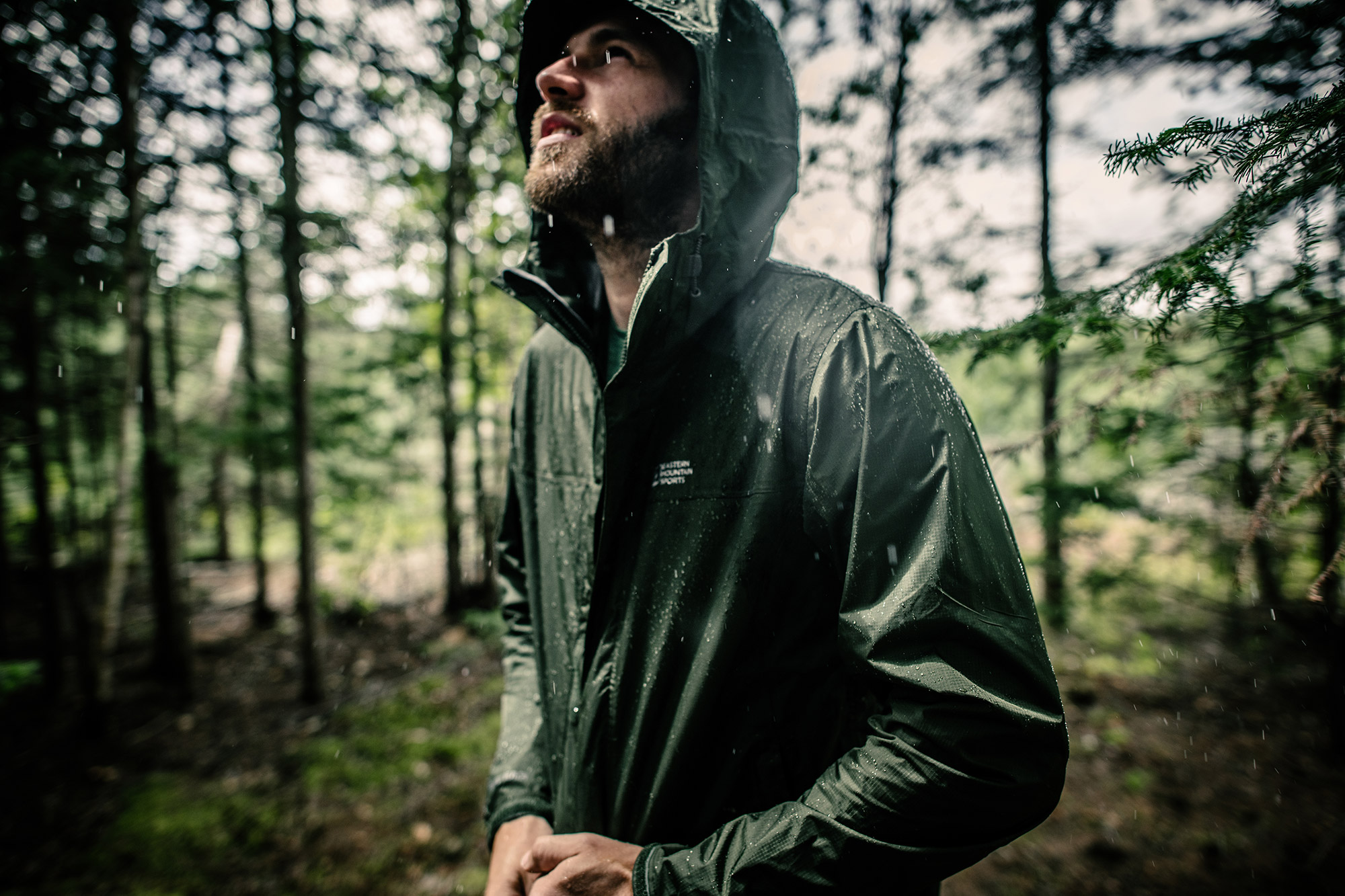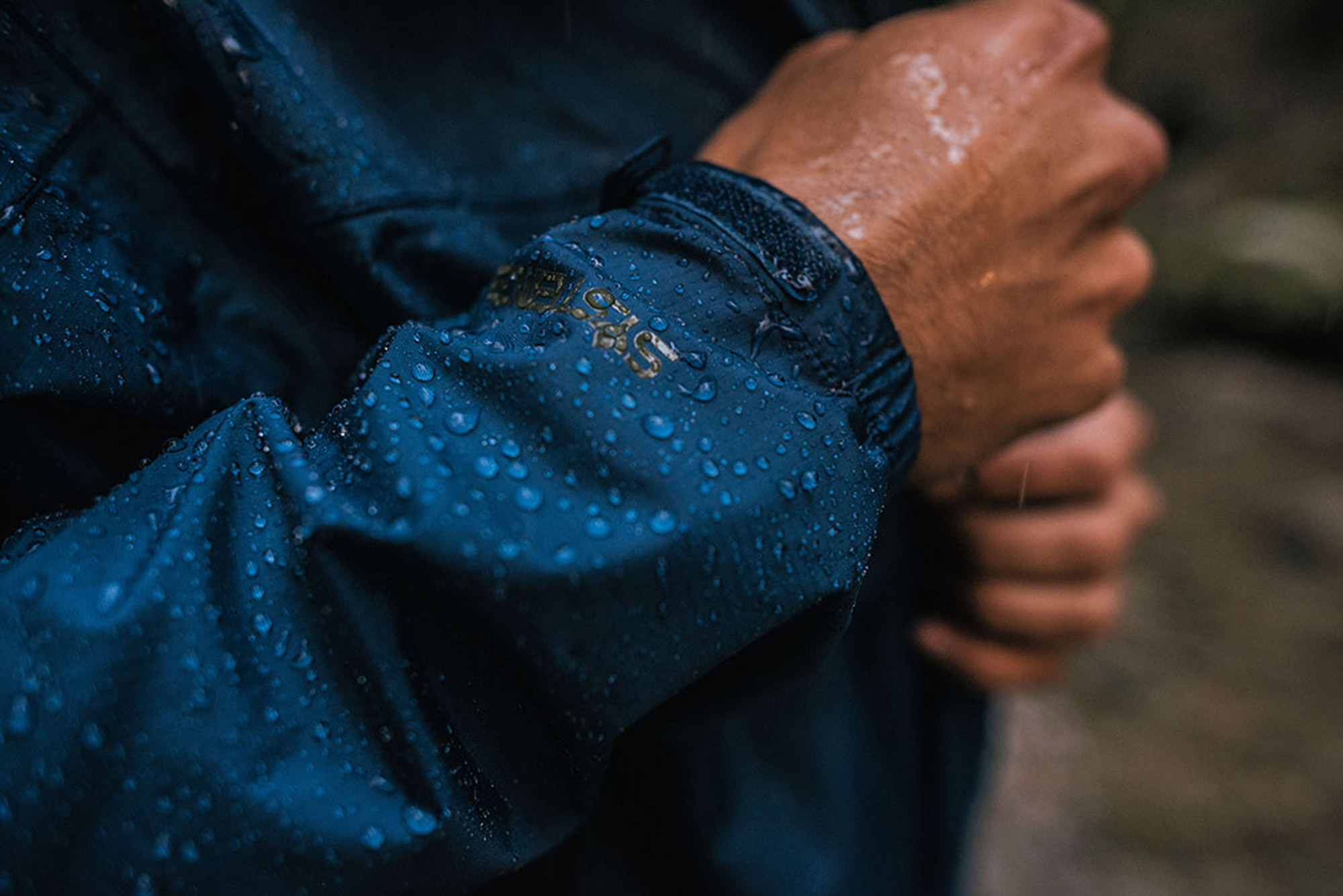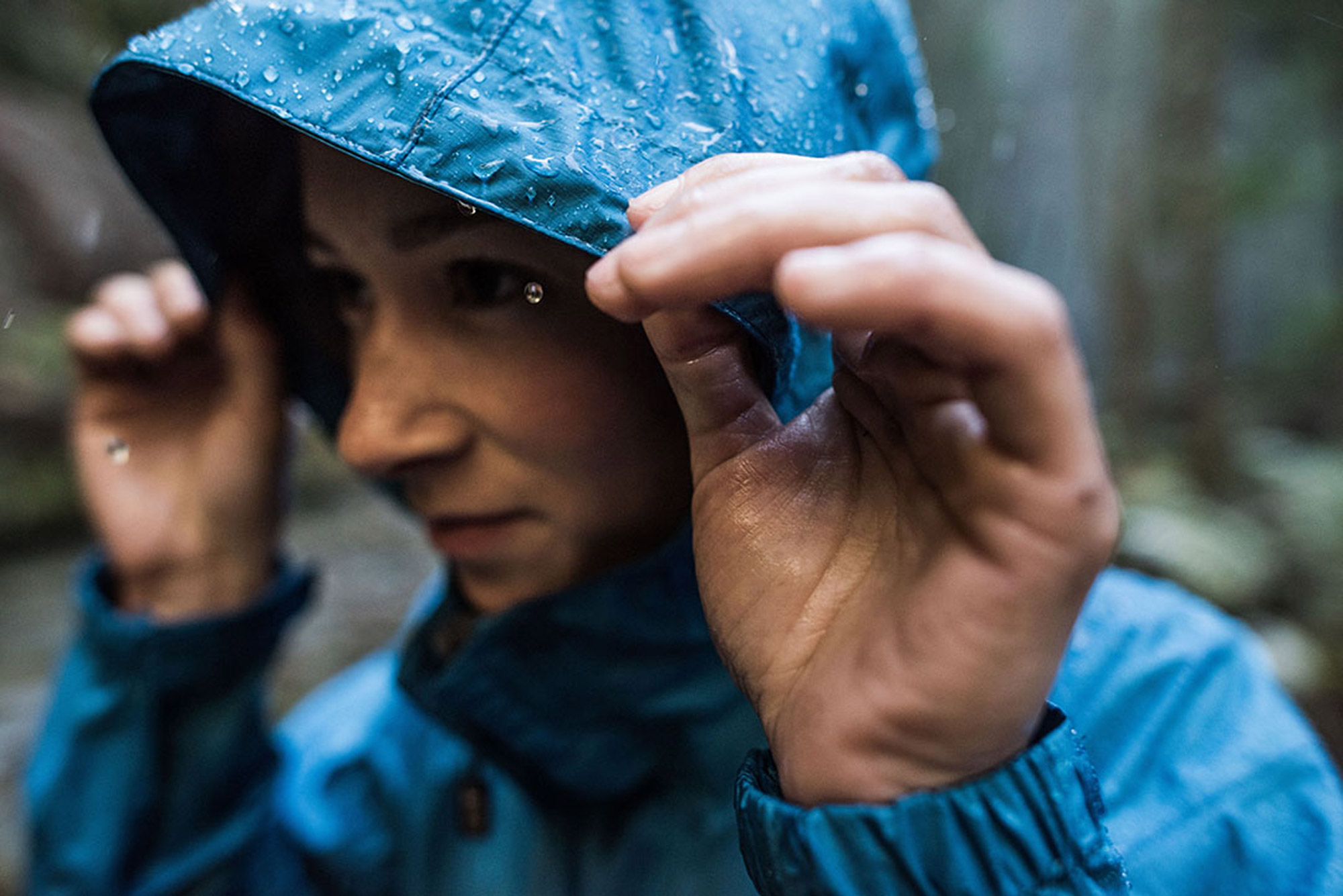When you need a good rain shell, you really need a good rain shell. When the clouds open up or the wind kicks in, having a good layer between you and the elements is essential to keeping you moving, happy, comfortable, and safe in the mountains. But the diversity of rain shells available to shoppers today is incredible, with jackets ranging from under $100 to pushing well above $500. So what is the difference between these shells? And, more important, what type of raincoat is “best” for what you want to do?

Waterproofness and Breathability
No matter the outdoor activity, you’ll want a jacket that’s waterproof and breathable (i.e., a jacket that prevents rain from penetrating the shell while also moving perspiration from the inside of the jacket to the outside). Because waterproof/breathable jackets must account for moisture in both directions—shielding water on the exterior and moving moisture from the interior—they compromise some of both attributes to balance performance.
For example, a rubber rain slicker is great at keeping water out, but because rubber doesn’t breathe, wearing one while doing anything active will leave you soaked in sweat. Likewise, a Techwick t-shirt excels at moving moisture, but don’t expect it to keep you dry during a rainstorm. Fortunately for consumers, the industry has developed two ratings (a waterproofness rating and a breathability rating) to indicate how a jacket will perform and make comparing products easier.
Waterproof Ratings
A raincoat’s water resistance is measured by how many millimeters of water it will hold before it leaks—most commonly represented as 20K, 15K, and 10K. To paint a clearer picture, imagine putting a one-inch by one-inch tube on your 10K-rated raincoat—you could fill that tube with water to a height of 10,000 mm before water would begin to leak through. That’s almost 33 feet high!
READ MORE: 10K, 20L? What Waterproof and Breathability Ratings Really Mean
Jackets rated to 10K are generally capable of handling light rain and snow for a short amount of time, while 15K-rated jackets can protect against moderate rain and snow for a longer duration. 20K-rated jackets provide the best defense against moisture and are able to guard against heavy rain and wet snow.
Breathability Rating
A shell’s breathability is also represented as 20K, 15K, and 10K, only this time the number is representative of the amount of water vapor it can move through one square meter of fabric—from inside to out—over the course of 24 hours.
Jackets with breathability rated to 10K are ideal for less vigorous activities where you’re less likely to break a sweat, like commuting and travel while 15K jackets are slightly more breathable and better-suited for things like alpine skiing or ice climbing. Jackets rated to 20K provide maximum breathability and are the choice of athletes moving quickly through the mountains: hikers, climbers, and anyone doing something more physical.
While these jackets are rated for breathability, it’s worth noting that numerous factors, such as the temperature and humidity, can affect the breathability of a jacket.
Air Permeability
Although breathability and air permeability are often used interchangeably, there is a subtle difference between the two. A waterproof/breathable raincoat needs water buildup or pressure inside the jacket to push moisture out—meaning moisture transport stops when a person stops moving. Conversely, air permeable shells constantly allow air and moisture in and out. However, because air permeable shells allow constant air exchange, they are not completely windproof like traditional waterproof/breathable jackets.
Air permeable shells are still in their relative infancy and can cost substantially more than a traditional raincoat. Keep your eyes peeled for more of these slick slickers in the future.

2-Layer, 2.5-Layer, and 3-Layer Construction
Rain shells are constructed in three different ways: 2-layer, 2.5-layer, and 3-layer. In many respects, how a jacket is constructed explains its performance better than its waterproof/breathability rating, with 3-layer raincoats being the highest performing and 2-layer jackets being the lowest.
3-Layer Raincoats
3-layer rain jackets are constructed by bonding three layers of fabric together, with a waterproof/breathable membrane sandwiched between a face and liner fabric. The body-facing liner fabric helps prevent sweat and oils from clogging the microscopic pores of the waterproof membrane (for improved breathability), while also helping disperse moisture on the jacket’s inside. Because of this, 3-layer jackets often don’t feel as clammy as other types of shells. The multiple layers also make these shells the most rugged and durable of the three types of raincoats—making them the best choice for people who spend a lot of time outdoors and in wet weather. There is, however, a performance premium, as 3-layer shells can be heavier than other options.
2.5-Layer Raincoats
Most shells found at Eastern Mountain Sports, and other retailers, are 2.5-layer shells. 2.5-layer shells are made of a face fabric that’s bonded with a waterproof/breathable membrane with an inner coating (the half layer) designed to protect the membrane from abrasion and microscopic-pore clogging sweat, oil, and dirt from your body. Balancing performance and affordability, 2.5-layer shells breathe well and are durable, packable, and reasonably priced, making them a great choice for enthusiasts on a budget.
2-Layer Raincoats
The improvements in technology and the subsequent reduction in prices of 2.5-layer jackets have, for the most part, relegated 2-layer jackets to urban and non-technical use. Two-layer raincoats feature a waterproof/breathable membrane bonded to an outer face fabric. Because 2-layer shells lack the half-layer found on the insides of 2.5-layer coats, they often use an additional hanging liner of mesh (or other lightweight material) to protect the membrane.

Waterproof/Breathable Membrane
The most well-known waterproof/breathable membrane is GORE-TEX, a high-performance fabric that has set the standard for rain jackets for the last 25 years. There are now several types of GORE-TEX membranes in addition to the original: Active (for, you guessed it, highly aerobic activities), Pro (for the most extreme conditions), and Paclite (for lightweight, super-packable shells).
Almost every company making outdoor clothing has a proprietary waterproof/breathable membrane. For EMS, it’s System 3; for The North Face, it’s HyVent; and for Marmot, it’s MemBrain. They are all great and, because they are company-specific, sometimes mean that you’ll be getting a more reasonable price on the jacket.
The final membrane worth mentioning is NeoShell. Manufactured by Polartec, it’s most interesting because it is as waterproof/breathable as the other membranes, without requiring as much internal pressure buildup to force the exchange. In other words, NeoShell provides more natural thermoregulation.
Durable Water Repellents (DWR)
Almost all waterproof/breathable rain shells feature a durable water repellent finish (DWR). The DWR finish found on raincoats is what causes water to bead up and roll off the outside of the jacket. However, this finish wears off over time and with use. When the DWR finish wears off, the jacket’s surface fabric can soak through, negatively affecting the breathability of the jacket and giving the jacket a cold, clammy feeling.
Luckily, reapplying the DWR treatment to your shell is easy.
READ MORE: A Guide to Picking the Ridge Nikwax Product

Other Features
With all the technical aspects of today’s raincoats covered, there are still some other features that you should consider before purchasing your next raincoat.
Hood
An overwhelming majority of raincoats have hoods. After all, how good can a jacket designed to protect you from the rain be with a giant hole in the top? A nice touch found on many of the hoods on today’s jackets are adjustments to ensure a proper fit. Another consideration, especially if you plan to use the raincoat for mountaineering, ice climbing, or skiing, is if the jacket’s hood can accommodate a helmet.
Seam Taping vs. Welding
Rain shells are built by combining multiple sections of waterproof/breathable material together. Manufacturers use two methods to secure these pieces—typically the body, arms, and hood—together: stitching and welding (attaching pieces with adhesive or fusing the pieces with ultrasonic bonding), both of which result in seams.
Welding seams is the lightest and least bulky option. The other advantage of welded seams is that there are no holes in the fabric, so water can’t sneak in.
Rain jackets that are stitched together require seam tape to waterproof the holes created by sewing. There are two common methods of seam taping: “fully taped” and “critically taped.” On a fully taped shell, every seam is covered with tape, while a critically taped shell typically only has the most critical seams taped.
It’s not uncommon to find raincoats using both methods of construction with high-usage, high-stress areas like arms and shoulders while incorporating welded construction into zippers and pockets.

Denier
The denier of the fabric used to make a raincoat is another clear indicator of the jacket’s overall durability. The denier of a fabric refers to its density—the higher the number the denser (and therefore stronger), the fabric is. So if you’re planning on doing a lot of abrasive outdoor activities, get a jacket with a high denier number.
Zippers
Zippers are another chink in a rainshell’s armor. Manufacturers address this in one of two ways: a laminated zipper or a storm flap. Laminated zippers offer users a waterproof zipper option and are lighter and more packable, but they can also be tricky to zip. Less effective but more affordable, a storm flap is simply an additional piece of fabric that covers the zipper that prevents it from being directly exposed to rain and snow.
It’s also not uncommon to find jackets with both types of zippers—for example, the main zipper with a storm flap and pockets with laminated zippers.
Venting
Even the best rain jackets can fail to keep up with a user’s breathability needs during strenuous activity. Because of this, most rainwear features some manner of venting. The most common style of venting is pit zips or underarm vents. However, some jackets use other methods, like large pockets on the torso that double as vents. No matter what system is used, the idea is the same—to allow better air circulation.
Packability
Another consideration when choosing a rain shell is how packable it needs to be. If you’re using a shell for alpine skiing, the answer may be not very, but if you’re pursuing light-and-fast hikes, a super-packable shell might be very beneficial. Be aware, however, that ultralight raincoats typically have to make a sacrifice in order to achieve their lighter status, which means they’re either not as rugged or waterproof as more robust models.
Fit
Fit is another important characteristic to deliberate before buying your next raincoat, since the way the jacket fits will affect how you use it going forward. When sizing your raincoat, consider whether or not you plan on layering underneath it. If so, keep in mind that you’ll need extra room to accommodate those layers. Indeed, you may even find that you’ll need different rainwear for different conditions.
Do you have any tips for selecting a rain shell? If so, we want to hear them—leave them in the comments section below.

Tim Peck and Doug Martland
Tim and Doug met long ago at the Eastern Mountain Sports in Canton, Massachusetts. Bonding over a love of slick Quincy Quarry granite, White Mountain sufferfests, and scheming up adventures while folding tee-shirts, today Tim and Doug collaborate to write about their favorite outdoor activities and occasionally get nostalgic about tee-shirt tables.




